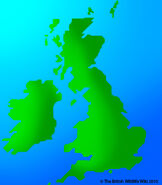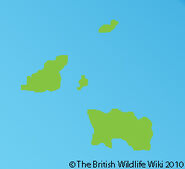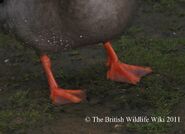
Female Mallard - WWC Archives
The Mallard (Anas platyrhynchos) is a common water bird in the UK.
Mallards are Britain's most common surface feeding duck. It lives in a variety of habitats and many have become tame due to living near human populations. It has the ability to virtually fly vertically into the air from a position on the water suface. Its broad beak allows it to filter food from the water. Mallards eat almost anything from insects to berries and plants. Its feet are webbed and when it walks it waddles. Nests are usually made from vegetation and are sited near water but are well hidden. During the courtship period the drake (male) gives a bold display and several follow a certain female and then she picks the one she likes the most. 8 to 12 pale green eggs are laid usually between March and May and are incubated for around 4 weeks.
Description[]
The Mallard is 56–65 centimetres (22–26 in) long (of which the body makes up around two-thirds), has a wingspan of 81–98 centimetres (32–39 in), and weighs 0.9–1.2 kilograms (32–42 oz). The breeding male is unmistakable, with a bright bottle-green head, black rear end and a yellowish orange (can also contain some red) bill tipped with black (as opposed to the black/orange bill in females). It has a white collar which demarcates the head from the purple-tinged brown breast, grey brown wings, and a pale grey belly. The dark

Male Mallard - Thomas
tail has white borders. The female Mallard is a mottled light brown, like most female dabbling ducks, and has buff cheeks, eyebrow, throat and neck with a darker crown and eye-stripe However, both the female and male Mallards have distinct purple speculum edged with white, prominent in flight or at rest (though temporarily shed during the annual summer moult). Upon hatching, the plumage coloring of the duckling is yellow on the underside and face (with streaks by the eyes) and black on the backside (with some yellow spots) all the way to the top and back of the head. Its legs and bill are also black but they gradually change color with age. As it nears the end of the fledgling period, the duckling is now a juvenile and its plumage becomes drab, looking more like the female (though its plumage is more streaked), but its gender can be easily distinguished by the coloring of its bill: Black/orange for females and yellow for males plus a slightly reddish breast. During the final period of maturity leading up to adulthood, the plumage of female juveniles remains the same while the plumage of male juveniles slowly changes to its recognizable colors. This also applies to adult Mallard males near the end of the molting period when they transition out of their non-breeding (eclipse) plumage.

Male Mallard face - http://www.flickr.com/photos/48035701@N04/
Several species of duck have brown-plumaged females which can be confused with the female Mallard. The female Gadwall (A. strepera) has an orange-lined bill, white belly, black and white speculum which is seen as a white square on the wings in flight, and is a smaller bird.
In captivity, domestic ducks come in wild-type plumages, white, and other colours. Most of these colour variants are also known in domestic Mallards not bred as livestock, but kept as pets, aviary birds, etc., where they are rare but increasing in availability.
A noisy species, the male has a nasal call, and a high-pitched whistle, while the female has a deeper "quack" stereotypically associated with ducks.
The Mallard is a rare example of both Allen's Rule and Bergmann's Rule in birds. Bergmann's Rule, which states that polar forms tend to be larger than related ones from warmer climates, has numerous examples in birds. Allen's Rule says that appendages like ears tend to be smaller in polar forms to minimize heat loss, and larger in tropical and desert equivalents to facilitate heat diffusion, and that the polar taxa are stockier overall. Examples of this rule in birds are rare, as they lack external ears. However, the bill of ducks is very well supplied with blood vessels and is vulnerable to cold.
Distribution and habitat[]
The Mallard is widely distributed across the Northern Hemisphere, North America from southern and central Alaska to Mexico, the Hawaiian Islands, and across Eurasia, from Iceland and southern Greenland and parts of Morocco (North Africa) in the west, Scandinavia to the north, and to Siberia, Japan, and China in the east. It is strongly migratory in the northern parts of its breeding range, and winters farther south. For example, in North America it winters south to Mexico, but also regularly strays into Central America and the Caribbean between September and May.
The Mallard inhabits a wide range of habitat and climates, from Arctic Tundra to subtropical regions. It is found in both fresh- and salt water wetlands, including parks, small ponds, rivers, lakes and estuaries, as well as shallow inlets and open sea within sight of the coastline. Water depths of less than 1 m (4 ft) are preferred, birds avoiding areas more than a few metres deep. They are attracted to bodies of water with aquatic vegetation. blah blah blah hahahaaaaa ew this webpage is ew
Behaviour[]
Feeding[]
The Mallard is omnivorous and very flexible in its food choice. Its diet may vary based on several factors, including the stage of the breeding cycle, short term variations in available food, nutrient availability, and inter- and intraspecific competition. The majority of the Mallard's diet seems to be made up of gastropods, invertebrates (including beetles, flies, lepidopterans, dragonflies, and caddisflies), crustaceans, worms, many varieties of seeds and plant matter, and roots and tubers. During the breeding season, male birds were recorded to have eaten 37.6% animal matter and 62.4% plant matter, most notably Echinochloa crus-galli, and nonlaying females ate 37.0% animal matter and 63.0% plant matter, while laying females ate 71.9% animal matter and only 28.1% plant matter. Plants generally make up a larger part of the bird's diet, especially during fall migration and in the winter.
It usually feeds by dabbling for plant food or grazing; there are reports of it eating frogs. It usually nests on a river bank, but not always near water. It is highly gregarious outside of the breeding season and will form large flocks, which are known as a sord.
Breeding[]
Mallards usually form pairs (in October and November) only until the female lays eggs at the start of nesting season which is around the beginning of spring (early March to late April), at which time she is left by the male who will join up with other males to await the molting period. During the brief time before this, however, the males are still sexually potent and they will either sire replacement clutches (for female Mallards that have lost or abandoned their previous clutch) or forcibly mate with females of a different species that appear to be isolated or unattached. This period can be very stressful for the female as she lays more than half her body weight in eggs and requires a lot of rest and a feeding/loafing area that is safe from predators. When seeking out a suitable nesting site, the female's preferences are on areas that are well concealed, are inaccessible to ground predators, and/or have few to no predators living nearby. This unfortunately includes urban areas that have roof gardens, enclosed courtyards, and flower boxes on window ledges/balconies more than one story up which prevents the ducklings from leaving safely or at all without human intervention. The clutch is 8–13 eggs, which are incubated for 27–28 days to hatching with 50–60 days to fledgling. The ducklings are precocial, and can swim and feed themselves on insects as soon as they hatch, although they stay near the mother for warmth and protection.
When they pair off with mating partners, often one or several drakes will end up "left out". This group will sometimes target an isolated female duck, even when she's of a different species, and proceed to chase and peck at her until she weakens, at which point each male will take turns copulating with the female. Lebret (1961) calls this behaviour 'Attempted Rape Flight' and Cramp & Simmons (1977) speak of 'rape-intent flights'. Male Mallards will also occasionally chase other male ducks of a different species, and even each other, in the same way. In one documented case of 'homosexual necrophilia', a male Mallard copulated with another male he was chasing after said male had been killed upon flying into a glass window.
Mallards are opportunistically targeted by brood parasites, occasionally having eggs laid in their nests by Redheads, Ruddy Ducks, Lesser Scaup, Gadwalls, Northern Shovelers, Northern Pintails, Cinnamon Teal, Common Goldeneyes and other Mallards. These eggs are generally accepted when they resemble the eggs of the host Mallard, although the hen may attempt to eject them or even abandon the nest if parasitism occurs during egg laying.
Conservation[]
The release of feral Mallards in areas where they are not native sometimes creates problems through interbreeding with indigenous waterfowl. These non-migratory Mallards interbreed with indigenous wild ducks from local populations of closely related species through genetic pollution by producing fertile offspring. Complete hybridization of various species of wild ducks gene pools could result in the extinction of many indigenous waterfowl. The wild Mallard itself is the ancestor of most domestic ducks and its naturally evolved wild gene pool gets genetically polluted in turn by the domesticated and feral populations.
The Mallard is considered an invasive species in New Zealand. There, and elsewhere, Mallards are spreading with increasing urbanization and hybridizing with local relatives. Over time, a continuum of hybrids ranging between almost typical examples of either species will develop; the speciation process beginning to reverse itself. This has created conservation concerns for relatives of the Mallard, such as the Hawaiian Duck, the A. s. superciliosa subspecies of the Pacific Black Duck, the American Black Duck, the Mottled Duck, Meller's Duck, the Yellow-billed Duck, and the Mexican Duck, in the latter case even leading to a dispute whether these birds should be considered a species (and thus entitled to more conservation research and funding) or included in the Mallard.
In the state of Florida, domestic ownership of Mallards is currently banned. This is to prevent hybridisation with the native Mottled Duck.
Mallards are also causing severe "genetic pollution" of South Africa's biodiversity by breeding with endemic ducks, although the Agreement on the Conservation of African-Eurasian Migratory Waterbirds applies to the Mallard. The hybrids of Mallard and the Yellow-billed Duck are fertile and can produce more hybrid offspring. If this continues, only hybrids will occur and in the long term this will result in the extinction of various indigenous waterfowl. The Mallard duck can cross breed with 63 other species and is posing a severe threat to the genetic integrity of indigenous waterfowl. Mallards and their hybrids compete with indigenous birds for resources such as food, nest sites and roosting sites.
The Chinese Spotbill is currently introgressing into the Mallard populations of the Primorsky Krai, possibly due to habitat changes from global warming. The Mariana Mallard was a resident allopatric population—in most respects a good species—apparently initially derived from Mallard-Pacific Black Duck hybrids; unfortunately, it became extinct in the 1980s. In addition, feral domestic ducks interbreeding with Mallards have led to a size increase—especially in drakes—in most Mallards in urban areas. Rape flights between normal-sized females and such stronger males are liable to end with the female being drowned by the males' combined weight.
The Laysan Duck is an insular relative of the Mallard with a very small and fluctuating population. Mallards sometimes arrive on its island home during migration, and can be expected to occasionally have remained and hybridized with Laysan Ducks as long as these species exist. But these hybrids are less well adapted to the peculiar ecological conditions of Laysan Island than the local ducks, and thus have lower fitness, and furthermore, there were—apart from a brief time in the early 20th century when the Laysan Duck was almost extinct—always much more Laysan Ducks than stray Mallards. Thus, in this case, the hybrid lineages would rapidly fail.
In the cases mentioned above, however, ecological changes and hunting have led to a decline of local species; for example, the New Zealand Grey Duck population declined drastically due to overhunting in the mid-20th century. In the Hawaiian Duck, it seems that hybrid offspring are less well-adapted to native habitat and that utilizing them in reintroduction projects makes these less than successful. In conclusion, the crucial point underlying the problems of Mallards "hybridizing away" relatives is far less a consequence of Mallards spreading, but of local ducks declining; allopatric speciation and isolating behaviour have produced today's diversity of Mallard-like ducks despite the fact that in most if not all of these populations, hybridization must have occurred to some extent.
Similar species
Shoveler, which is slightly smaller with browner plumage. Female could be confused with female Gadwall
Gallery[]
Videos[]

British Wildlife Clips - Mallard
British Wildlife Clips - Mallard









